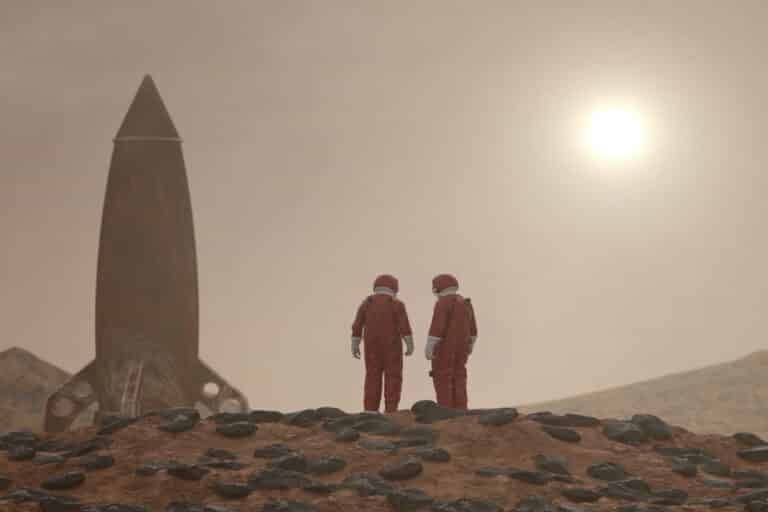Scientists have found the perfect solution to building on Mars: human blood

A possible solution for building on Mars was right under our noses all along—or rather, under our skin. Doctor Aled D. Roberts, from the Future Biomanufacturing Research Hub, has announced perhaps the gnarliest scientific proposition to date: using human blood as glue for Mars dust… As the proverbial phrase goes, ‘you can’t get blood out of stone’, but you can get it out of a human. Science has never been so hardcore.
A bloody good discovery
Like many scientific discoveries, the idea of using human blood for creating Martian structures was not deliberate—it was stumbled upon. Roberts’ background is in chemistry with a PhD from Liverpool University, Singapore. He’s now based in Manchester where he focuses on the interface of materials chemistry, material science and biotechnology. It was there that his team were honing their scientific minds on using spider silk as a substitute for glue. “It was an accident really. In one of our controlled experiments we found that a protein from cow blood was very good at sticking grass together,” Roberts told Screen Shot.
“From there, we inferred that if it was good at sticking grass together it would also be good at sticking sand together because grass and sand are both made out of silica,” he continued. The dust on the Moon and Mars are also, coincidentally, made out of silica—and by that point, the team knew they were onto something big.
Obviously, it’s not feasible to ship a rocket full of cows into space—although, given the recent rise in billionaire space antics, it’s only a matter of time until that happens. The alternative? Human blood. As Roberts stated, “Humans also produce this protein which can be used to stick together Moon dust, Mars dust or sand—and any space mission which is crewed would have humans present.”
The basis of the paper, published in the journal Materials Today Bio, found that human blood protein compared with both Moon dust and Mars dust created a very strong, concrete-like material. “We found how it was sticking together, and based on our understanding found that compounding this with Urea (from human urine) increased the effect of the bonding mechanism,” Roberts added.
No, we won’t be seeing human blood farms on Mars
So, whenever humans do populate Mars, will human blood be the glue that holds our extra-terrestrial cities together? Unfortunately not. As all great scientists should do, Roberts delivers a healthy dose of realism into this sci-fi-esque scenario: “The best it would probably be used for is motor or to stick sandbags together.”
However, that doesn’t mean it’s not “incredibly useful to research and understand.” Between Mars and Earth, there is a significant delay in communications. Roberts noted how “it can take around 40 minutes for communication between the two planets. If the astronauts are in a life-threatening emergency, they would essentially have to fend for themselves. It’s useful to know that they could potentially make strong hard materials using their own blood and urine.”
Although, as metal as it might be to make structures out of human blood, Roberts indicated how there could be alternative ways to create the ‘glue’ which holds elements together too. “It doesn’t have to be human blood. We can, potentially, make synthetic proteins if we advance to a point where we can do that on Mars. Or, we could use similar proteins from plants—like teas or soybeans—and genetically engineer them to produce sticky proteins. That way they could be used as a food source or for glue as well.”
The team’s rather “tongue-in-cheek” study has boiled some blood—admittedly from people who have misunderstood the premise of the research altogether. Roberts shared that “some people have taken it seriously, thinking we’ll be farming and exploiting people: using them like cattle for resources. It’s unethical to even consider doing that—I don’t think it’d be realistic to have humans sucked up to machines to build huge buildings. This is more theoretical. It’s to help astronauts understand that it is an option in a hypothetical emergency situation.”
The influence it can have on Earth
So we won’t be seeing human blood farms on Mars, although that would be an incredibly sci-novel premise—aspiring authors looking for new inspiration, you can thank me later. Despite this, the research does have significant implications for life back down on Earth. Roberts explained how often space technologies, however outlandish they may first appear, have a “trickle-down effect” which eventually influences our advancement on Earth.
“If you’re an investor and want to build something on the Moon or Mars you can’t have any extra weight—everything you make has to be sustainable,” he noted, and for Earth—as the planet continues to warm, oceans rise and waste builds—we need to become more sustainable.
Concrete, for example, uses 8 per cent of global greenhouse gas carbon dioxide emissions. Roberts believes his research could help us find a valuable alternative. “This is just the start, we could potentially further develop this concept into a technique which uses plant-based proteins or other sustainable resources. This could help us find a relatively low carbon alternative for construction materials like cement, tiles, all that kind of stuff.”
Despite how it may appear at first glance, this scientific discovery is far from a gimmick. We’ve only scratched the surface of what this technological advancement could bring to society. Although our great mission to colonise Mars has been the initial focal point of this research, it has a huge potential for life down on Earth too. Who knows, maybe in a few decades time we’ll all be living in houses made of plant blood… Only time will tell.





